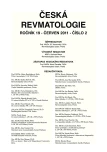Occurrence of infections under treatment with TNF alpha antagonists in ATTRA registry
Authors:
O. Šléglová 1; L. Burešová 2; J. Vencovský 1; K. Pavelka 1
Authors‘ workplace:
Revmatologický ústav, Praha, 2Institut biostatistiky a analýz, Brno
1
Published in:
Čes. Revmatol., 19, 2011, No. 2, p. 86-91.
Category:
Posts from Congress
Overview
The issue of infections on biological therapy has been widely discussed. According to clinical studies, anti-TNF alpha therapy obviously increases susceptibility to common infections. However, if we take a closer look at this issue, there is no completely clear opinion on the risk of severe infections, especially if patients are compared to a group treated with conventional agents and further risk factors are taken into account. According to published studies, the highest risk of infection follows the initiation of treatment, and infections occur more frequently during the first year of therapy. As to the localization, the respiratory system is most commonly affected. When the group of patients treated with anti-TNF alpha agents was compared with patients on conventional therapy, higher occurrence of infections of the skin, soft tissues and joints was described. In general, tendency towards granulomatous inflammation is increased. Aside from demonstrably increased risk of tuberculosis, which, however, is not elaborated in this article, there is also an increased risk of mycotic and some other infections during the anti-TNF alpha therapy. Out of viral infections, higher occurrence of herpes zoster has been described in association with monoclonal antibody therapy. Cases of hepatitis B reactivation have been reported in literature as well. In the article, we present the data from the Czech national registry of biological therapy (ATTRA). These data vary in some aspects from the published studies. Nevertheless, the numbers are still rough, for some entered parameters need to be specified and unified and the missing data provided.
Key words:
TNF alpha blocking agents, infections, rheumatic diseases
Sources
1. Doran MF, Crowson CS, Pond GR, et al. Frequency of infection in patients with rheumatoid arthritis compared with controls: a population based study. Arthritis Rheum 2002; 46: 2287-93.
2. Doran MF, Crowson CS, Pond GR, et al. Predictors of infection in rheumatoid arthritis. Arthritis Rheum 2002; 46: 2294-300.
3. Hernandez-Cruz B, Cardiel MH, Villa AR, Alcocer-Varela J. Development, recurrence, and severity of infections in Mexican patients with rheumatoid arthritis: a nested case-control study. J Rheumatol 1998; 25: 1900-07.
4. Van der Veen MJ, van der HeideA, Kruize AA, Bjilsma JW. Infection rate and use of antibiotics in patients with rheumatoid arthritis treated with methotrexate. Ann Rheum Dis 1994; 53: 224-28.
5. Vencovský J. a výbor České revmatologické společnosti. Bezpečnost biologické léčby-doporučení České revmatologické společnosti. Čes Revmatol 2009:149-160.
6. Listing J, Strangfeld A, Kary S et al. Infections in patients with rheumatoid arthritis treated with biologic agents. Arthritis Rheum 2005; 52: 3403-12.
7. Furst DE, Keystone EC, Winthrop K, et al. Update consensus statement on biological agents for the treatment of rheumatic diseases 2009; Ann Rheum Dis 2010; 69: i2-i29.
8. Bongartz T, Sutton AJ, Sweeting MJ et al. Anti-TNF antibody therapy in rheumatoid arthritis and the risk of serious infections and malignancies: systematic review and meta-analysis of rare harmful effects in randomized controlled trial. JAMA 2006; 295:2275-85.
9. Bernatsky S, Habel Y, Rahme E. Observational studies of infections in rheumatoid arthritis: a metaanalysis of tumor necrosis factor antagonists. J Rheumatol 2010; 37: 928-31.
10. Dixon WG, Watson K, Lunt M et al. Rates of serious infection, including site-specific and bacterial intracellular infection, in rheumatoid arthritis patients receiving anti-tumor necrosis factor therapy. Arthritis Rheum 2006; 54: 368-76.
11. Askling J, Fored CM, Brandt L, et al. Time –dependent increase in risk of hospitalisation with infection among Swedish RA patients treated with TNF antagonists. Ann Rheum Dis 2007; 66:1339-44.
12. Giles JT, Bartlett SJ, Gelber AC, et al. Tumor necrosis factor inhibitor therapy and risk of serious postoperative orthopedic infection in rheumatoid arthritis. Arthritis Rheum 2006;55:333-337.
13. Wallis RS, Broder MS, Wong JY, et al. Granulomatous infectious diseases associated with tumor necrosis factor antagonists. Clin Infect Dis 2004; 38: 1261-5.
14. Strangfeld A, Listing J, Herzer P, et al. Risk of herpes zoster in patients with rheumatoid arthritis treated with anti-TNFα agents. JAMA 2009; 301: 737-744.
15. Emery P, Fleischmann RM, Moreland LW, et al. Golimumab, a new human anti-TNFα monoclonal antibody, administered subcutaneously every 4 weeks in methotrexate –naive patients with active RA: a randomized, double-blind, placebo-controlled study (GO BEFORE) (abstract). EULAR 2008.
16. Nathan DM, Angus PW, Gibson PR. Hepatitis B and C virus infections and anti-tumor necrosis factor –alpha therapy: guidelines for clinical approach. J Gastroenterol Hepatol 2006; 21: 1366-71.
17. Giannitti C, Bellisai F, Ferri C, Galeazzi M. Treatment strategies for a patient with rheumatoid arthritis and hepatitis C. Expert Opin Pharmacother 2009; 10: 579-87.
Labels
Dermatology & STDs Paediatric rheumatology RheumatologyArticle was published in
Czech Rheumatology

2011 Issue 2
Most read in this issue
- Treatment with biological drugs in special situations (pregnancy, lactation, vaccination and surgery)
- Extraarticular manifestations of rheumatic diseases and the possibilities of their alleviation by biological therapy
- Biological therapy of rheumatoid arthritis and the risk of tumorous diseases
- Occurrence of infections under treatment with TNF alpha antagonists in ATTRA registry
